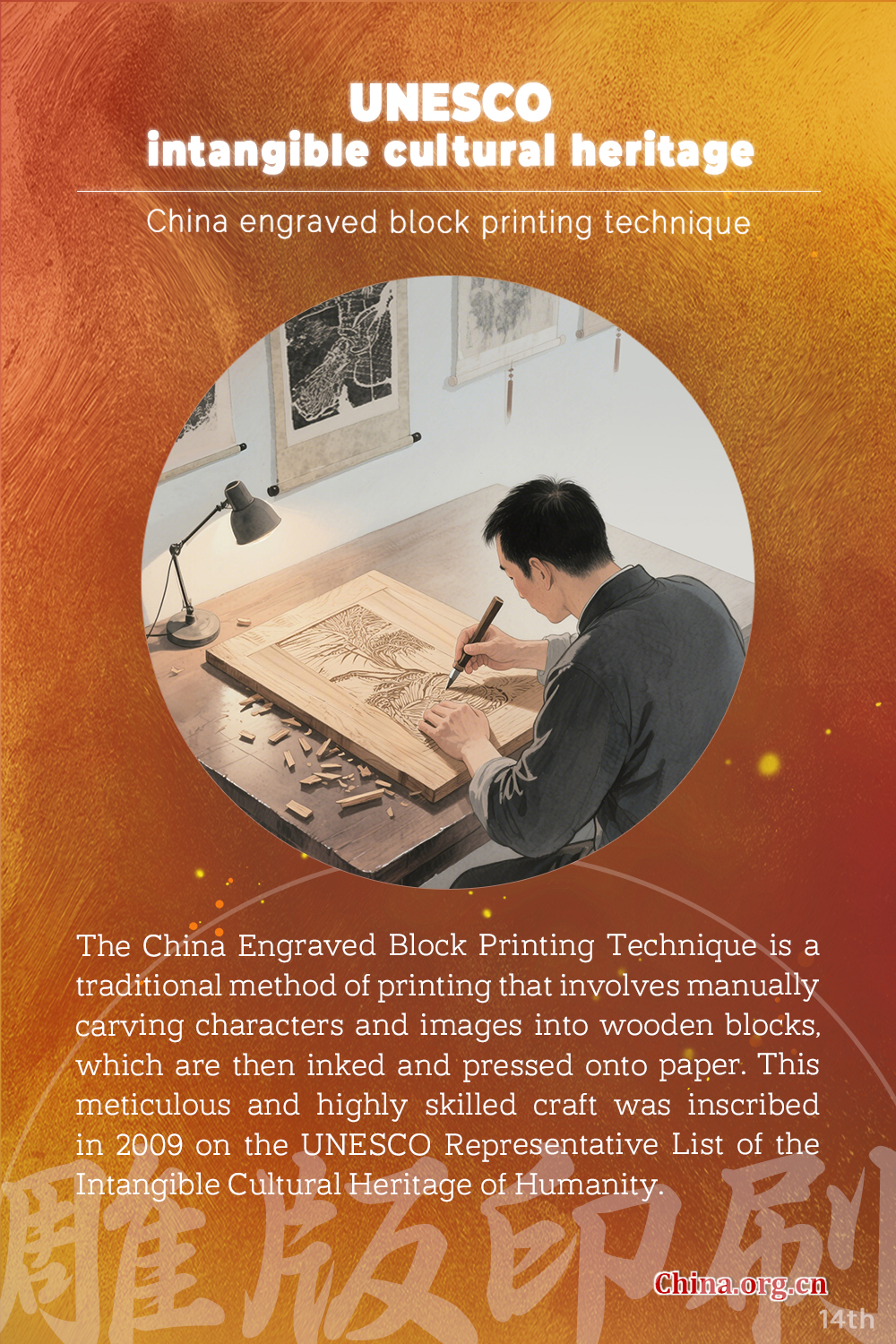
 0 Comment(s)
0 Comment(s) Print
Print E-mail China.cn, April 15, 2025
E-mail China.cn, April 15, 2025Editor's note: The China Engraved Block Printing Technique is a traditional method of printing that involves manually carving characters and images into wooden blocks, which are then inked and pressed onto paper. This meticulous and highly skilled craft was inscribed in 2009 on the UNESCO Representative List of the Intangible Cultural Heritage of Humanity. It is one of the oldest printing techniques in the world and has played a fundamental role in preserving and transmitting Chinese culture, literature, religion and philosophy.

This technique encompasses a complete production process that includes paper-making, brush calligraphy, block carving and printing. It reflects the deep interconnection between craftsmanship and intellectual life in traditional Chinese society, and is a living expression of cultural continuity.
The origins of the China Engraved Block Printing Technique date back to the Tang dynasty (618–907), with the Diamond Sutra, printed in 868, often cited as the earliest known printed book using engraved block printing. The practice flourished during the Song dynasty (960–1279), when it became widely adopted for reproducing Buddhist texts, Confucian classics, scientific treatises and works of literature.
During the Ming (1368–1644) and Qing (1644–1911) dynasties, engraved block printing developed into a highly sophisticated art form. Centers such as Hangzhou and Yangzhou became known for their exquisite craftsmanship and elegant publications. Printing houses operated at scale, with specialized artisans responsible for each stage: calligraphers wrote the original text, carvers engraved the reversed characters into pear wood blocks, and printers applied ink and pressed sheets of handmade paper to produce the final prints.
The engraved block printing technique not only enabled the spread of knowledge across social classes but also preserved a vast number of Chinese classics, medical texts, religious scriptures and illustrations for future generations.
With the rise of modern printing technologies in the 20th century, the traditional technique gradually declined. However, it has never disappeared entirely. Today, the engraved block printing technique survives in several regions, most notably Yangzhou and Nanjing of Jiangsu province and Dege county of Sichuan province, where dedicated artisans and cultural institutions continue to practice and promote it.
Efforts to preserve and revitalize the technique have been growing. Master artisans teach apprentices through hands-on training, and some universities and vocational schools include it in their curriculum. Cultural workshops, exhibitions and live demonstrations are also used to engage the public and spark new interest. In some cases, the technique has been adapted for artistic or educational purposes, including the reproduction of ancient texts and the creation of limited-edition prints.
Despite these positive developments, challenges remain. The technique requires long-term dedication, precision and collaboration across different crafts, making it difficult to sustain in a fast-paced, commercialized environment. Material costs, aging practitioners and limited market demand continue to pose threats to its future.
When UNESCO added the China Engraved Block Printing Technique to the Representative List of the Intangible Cultural Heritage of Humanity in 2009, it praised the tradition as "a traditional handicraft technique" that "has helped accelerate the development of social civilization, and therefore contributed greatly to the human progress." The evaluation recognized the intricate division of labor and the high level of cooperation required among artisans specializing in calligraphy, carving, printing and paper-making.
UNESCO also emphasized the technique's role in preserving and transmitting literature, religious beliefs and historical knowledge. It acknowledged the importance of local communities and governments in safeguarding the practice and noted the value of intergenerational transmission through master-apprentice training systems.
The inscription reflects global recognition of the technique's cultural significance and the urgent need for preservation. As a living expression of China's intellectual and artistic heritage, the China Engraved Block Printing Technique continues to inspire efforts in heritage education, artistic innovation and cultural exchange.
Discover more treasures from China on UNESCO's ICH list:
? 2024: Spring Festival
? 2022: Traditional tea processing
? 2020: Wangchuan ceremony, taijiquan
? 2018: Lum medicinal bathing of Sowa Rigpa
? 2016: Twenty-four solar terms
? 2013: Abacus-based Zhusuan
? 2012: Training plan for Fujian puppetry performers
? 2011: Shadow puppetry, Yimakan storytelling
? 2010: Peking opera, acupuncture and moxibustion, wooden movable-type printing, watertight-bulkhead technology of Chinese junks, Meshrep
? 2009: Yueju opera, Xi'an wind and percussion ensemble, traditional handicrafts of making Xuan paper, traditional firing techniques of Longquan celadon, Tibetan opera, sericulture and silk craftsmanship, Regong arts, Nanyin, Khoomei, Mazu belief and customs, Dragon Boat Festival, Manas, Craftsmanship of Nanjing Yunjin brocade, Xinjiang Uygur Muqam art, Hua'er
